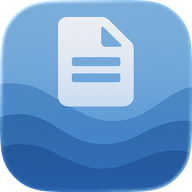Building StrataWrite: From Procrastination to Productivity
As a hobby project, I’ve created a new note-taking and writing app called StrataWrite. It began as an experiment for the Mac, and I’m now extending it to the iPad as well. I am an assistant professor, archaeologist, and unabashed Mac nerd.
My Apple journey started back in the 1990s as an undergraduate when I stumbled upon a lonely lab of Macintosh Classics. Everyone else gravitated to the PC labs, but the Mac immediately clicked for me. It worked the way my brain worked, and from then on I was hooked. Through graduate school and into my professional career, Macs have been my constant research and writing companions.
I write a lot for my research, but like many academics I’m also guilty of procrastinating by exploring workflows. StrataWrite started as another one of those experiments—perhaps even a procrastination crutch—but it has now grown into a tool I plan to “eat my own dog food” with, using it for real research and manuscripts.
Influences and Inspirations
I’ve used—and loved—apps like Ulysses for its minimalist interface, Scrivener for its power, and more recently Obsidian, Roam, and Craft. Obsidian fascinates me but never quite fits my process. The linking and Zettelkasten approach is brilliant for some, but I’m more of a structure-first thinker. For me, fast search and minimal structure beats elaborate organizing systems.
My Writing Process
My research writing begins with constant reading of PDFs—journal articles, chapters, and books. I highlight and annotate extensively. For citation management, I use Bookends by Sonny Software. It’s indie, Mac-first, and offers something I love: the ability to extract highlights with deep links back into the PDF. These links now integrate beautifully with StrataWrite.
Writing a research paper is always about structure: a central research question, supporting data, methodology, results, and contextual discussion. That structure is what organizes my notes. My students hear me say this often: without a research question, the paper collapses. StrataWrite reflects that same philosophy.
Why “StrataWrite”?
The name is inspired by archaeology. Strata are the layers of sediment and soil that accumulate over time, preserving artifacts of past lives. Similarly, StrataWrite layers notes, sources, and structures into something coherent. It also echoes ideas from practice theory (“structures structuring structures”) and even assembly theory in physics.
How StrataWrite Works
At its core, StrataWrite is powered by plain text notes:
- Notes are searchable through Apple’s Core Spotlight.
- They can be filtered by categories (Document, Source, Note, Journal) and tags.
- Search results are weighted by relevance, showing previews of context.
From there:
- Notes can be copied or exported as plain text files (individually or in bulk).
- Markdown preview makes links and formatting functional.
- Wiki-style links (
[note title]) create connections between notes, supported by a Links Panel for navigation.
I’ve also experimented with on-device AI features using Apple’s new foundation models: summarization, keyword extraction, and question-answering for short notes. These are still limited by context size, but the promise of private, on-device LLMs that can query all notes is on the horizon—and that excites me more than any current workaround.
The interface also supports collapsing panels for a distraction-free writing mode. And everything syncs across devices using CloudKit.
The Manuscripts View
Beyond notes, StrataWrite now includes a dedicated Manuscripts view. This is a separate window designed specifically for long-form writing:
- Word goal tracking helps writers pace progress over time.
- A basic outlining tool structures your draft in sections.
- By keeping manuscripts separate from notes, the app creates a focused environment for drafting research papers or long essays.
Future Plans
StrataWrite is still evolving, but here’s what’s next:
- A Spreadsheet view for writers who prefer organizing information in tables.
